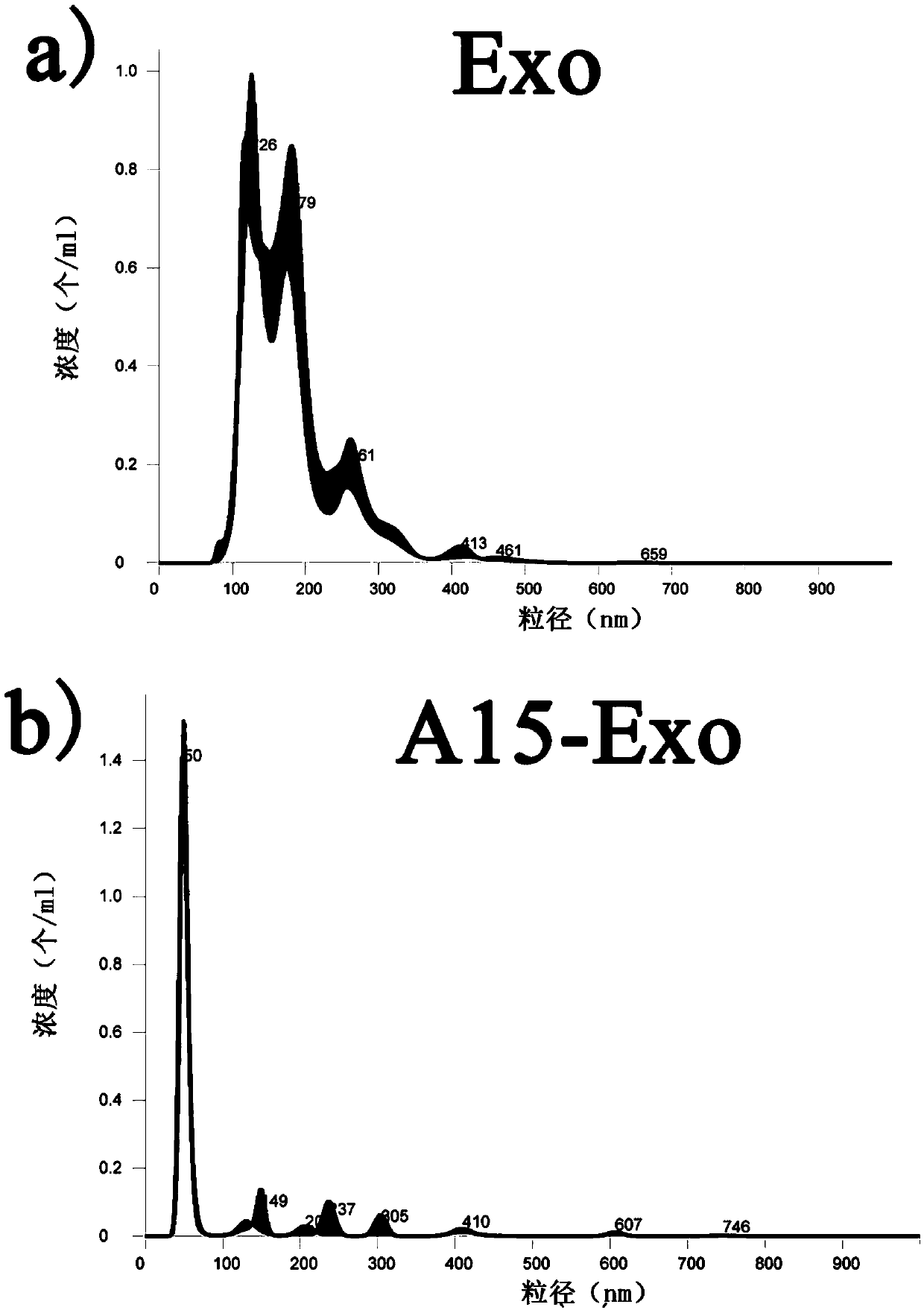Exosome carrier of target integrin alpha v beta 3 and preparation method and application of exosome carrier
A technology of integrins and exosomes, applied in the field of medicine, to achieve the effects of low immunogenicity, promotion of apoptosis, and mild reaction conditions
- Summary
- Abstract
- Description
- Claims
- Application Information
AI Technical Summary
Problems solved by technology
Method used
Image
Examples
Embodiment 1
[0055] Example 1: Extraction and transmission electron microscope observation of exosomes secreted by undifferentiated and differentiated THP-1 cells
[0056] Cultivate THP-1 mononuclear suspension cells at a culture density of 5×10 5 -10 6 / ml. Adjust the cell density to 6 x 10 5 / ml, add PMA at a concentration of 50ng / ml, stimulate the culture for 24 hours, wash the cells with PBS, replace with a medium that does not contain PMA and continue to culture for 1-5 days. In order to quickly obtain sufficient yield and relatively pure exosomes from a large volume of culture medium, it is proposed to combine ultrafiltration and ultracentrifugation to separate and extract exosomes. First, obtain cell-free medium by centrifugation, and then use gradient centrifugation: centrifuge at 300×g for 10 minutes, centrifuge at 1200×g for 20 minutes, and centrifuge at 10,000×g for 30 minutes to remove cell debris and microbubbles, etc., and then pass through a 0.22 μm microporous membrane ...
Embodiment 2
[0057] Example 2: Nanoparticle tracking analysis technology (NTA) of exosomes secreted by undifferentiated and differentiated THP-1 cells to investigate the concentration and particle size of the collected exosomes
[0058] Take the exosomes isolated in Example 1 to analyze their concentration and particle size by NTA method, use a 1ml syringe to take 200ul and dilute to 1ml, and analyze the sample concentration and particle size on the machine. The result is as image 3 , a) is the NTA result of the exosomes isolated from the THP-1 cell culture medium without PMA stimulation, b) is the NTA knot of the exosomes isolated from the THP-1 cell culture medium stimulated with PMA, the result It shows that the average particle size of exosomes secreted by undifferentiated THP-1 cells is 179.4nm, and the particle size of exosomes secreted by differentiated THP-1 cells is 94.1nm.
Embodiment 3
[0059] Example 3: Nanoparticle Tracking Analysis Technology (NTA) of exosomes secreted by undifferentiated and differentiated THP-1 cells investigates the protein identification of the collected exosomes
[0060] The two kinds of exosomes collected at the bottom of the centrifuge tube in Example 1 are the exosomes (Exo) secreted by undifferentiated THP-1 cells and the exosomes (A15-Exo) secreted by differentiated THP-1 cells . Add an appropriate amount of RIPA cell lysate, lyse on ice for 30 min, centrifuge at 13,000 g for 15 min, and take the supernatant. Protein quantification was performed according to the protein quantification kit (BCA method for quantifying protein), and an equal amount of protein was mixed with 5X denaturing buffer and boiled for 5 min. Prepare 10% separating gel, and separate the protein by SDS-PAGE electrophoresis, first at constant voltage 60V, electrophoresis for 50min, then at constant voltage 120V, electrophoresis for 2h. Cut the PVDF membrane a...
PUM
| Property | Measurement | Unit |
|---|---|---|
| The average particle size | aaaaa | aaaaa |
| Particle size | aaaaa | aaaaa |
Abstract
Description
Claims
Application Information
 Login to View More
Login to View More - R&D
- Intellectual Property
- Life Sciences
- Materials
- Tech Scout
- Unparalleled Data Quality
- Higher Quality Content
- 60% Fewer Hallucinations
Browse by: Latest US Patents, China's latest patents, Technical Efficacy Thesaurus, Application Domain, Technology Topic, Popular Technical Reports.
© 2025 PatSnap. All rights reserved.Legal|Privacy policy|Modern Slavery Act Transparency Statement|Sitemap|About US| Contact US: help@patsnap.com



